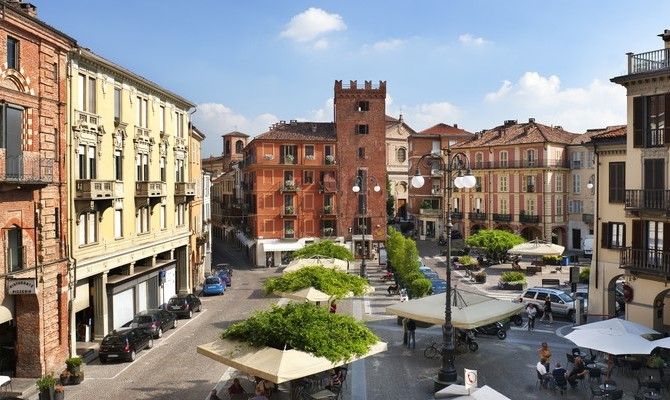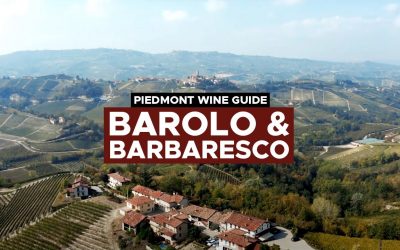Asti Travel Guide 2023: Where to stay, wineries, what to do
Welcome to the 2023 Asti Travel Guide. Nestled in the sun-drenched hills of Piedmont, Northern Italy, the historic city of Asti is an unmissable destination for wine lovers, history enthusiasts, and foodies alike. Asti is best known for its fine wines, particularly Asti Spumante and Moscato d’Asti. But the city offers much more than its renowned vineyards. It’s a place where every street and square whisper tales of a rich and colorful past, and where the cuisine is as much a journey of discovery as the landscape itself. From its roots as an ancient Roman city to its role as an important center during the Middle Ages, Asti is steeped in history. Wander its winding lanes and you’ll come across Romanesque churches, gothic towers, and baroque palaces. Each year, the city steps back in time during the Palio di Asti, a historic horse race that transforms the city into a vibrant spectacle of medieval pageantry.
Asti’s enogastronomic tradition is rich and varied, with many local dishes that are deeply rooted in the territory. The city and its surroundings are renowned for their exceptional produce, including truffles, peaches, and the prized Piedmontese beef. Of course, no trip to Asti would be complete without visiting its celebrated wineries. The region is home to some of Italy’s most prestigious wine producers, many of whom offer tastings and tours that offer a fascinating insight into the art and science of winemaking.
This guide will provide you with all the information you need to explore Asti. From the best places to stay and dine, to the must-visit wineries and top attractions, prepare to embark on a memorable journey through one of Italy’s most charming cities.
General Information about Asti, Piedmont, Italy
| Aspect | Detail | Highlight |
|---|---|---|
| Location | Situated in Piedmont, Northwestern Italy | Within driving distance of Turin, Milan, and Genoa |
| Historical Significance | Pre-Roman origins, flourished in Middle Ages | Known as the City of 100 Towers; Gothic-style Cathedral, medieval towers and palaces |
| Culinary Scene | Known for truffles, cheeses, and traditional dishes | Famous dishes include Agnolotti del Plin and Bagna Càuda |
| Wine Culture | Globally renowned wine region | Famous for Asti Spumante, Moscato d’Asti, and Barbera d’Asti |
| Festivals | Hosts various significant festivals | The Palio di Asti and Douja d’Or are notable annual events |
Asti is a city situated in the Piedmont region in the northwest of Italy. It’s known for its rich history and cultural heritage, making it a great destination for those who appreciate these aspects. Asti is also famed for its wine, notably Asti Spumante and Moscato d’Asti.
With its roots stretching back to pre-Roman times, Asti’s history is woven into its streets and structures. The city flourished in the Middle Ages and was known as the City of 100 Towers, of which some still stand today, providing a glimpse into its grand past. From its Gothic-style Cathedral to its medieval towers and palaces, the city’s architectural landscape is a testament to its historical significance.
Asti’s culinary scene is as robust as its history. The region is well-known for its gastronomy, particularly its white truffles, robust cheeses, and artisanal salumi. Traditional dishes such as “Agnolotti del Plin”, small meat-filled pasta, and “Bagna Càuda”, a warm dip made with garlic, anchovies, and olive oil, are regional staples.
Asti Travel Guide 2023: wineries, what to do

Best Time of Year to Visit Asti
The best time to visit Asti depends on what you’re looking to experience. The wine harvest season, from late September to October, can be a fascinating time to visit if you want to see the winemaking process. However, note that this is a busy time of the year, so you should make your bookings in advance.
Generally, the weather in Asti is most pleasant in spring (May-June) and early fall (September-October). During these periods (September in Astigiano), temperatures are mild to warm, which is ideal for exploring vineyards and enjoying outdoor activities.
Climate Considerations
Asti has a typically Mediterranean climate, with hot summers and cool winters. The warmest months are July and August, where temperatures can exceed 30 degrees Celsius (86 Fahrenheit), while the winter months (December to February) can be quite cold with temperatures falling around 0 degrees Celsius (32 Fahrenheit).
Rainfall in Asti is significant, with precipitation even during the driest month. The rainiest months are usually April and October. Keep in mind that the weather can affect the wine-growing season and wine-related activities.
Event Considerations
One of the most significant events in Asti is the Palio di Asti, a traditional Italian festival of medieval horse racing that has been held since the 13th century, typically in September. It’s a grand festival that draws visitors from across Italy.
A noteworthy series of events happens in September, known as “Settembre Astigiano” (Asti’s September). This month-long event comprises numerous cultural, food, and wine festivities, including the Douja d’Or Wine Festival, which showcases the finest Piedmontese wines, the Festival delle Sagre, where you can enjoy traditional local food, and the aforementioned Palio di Asti. Remember, events and festivals may change from year to year, so always check the most recent dates and information before planning your trip.
In summary, Asti offers an experience steeped in winemaking traditions, history, and culture. With its captivating medieval buildings, exceptional wines, and delightful local cuisine, it’s a must-visit destination for any lover of wine and Italian culture. Discover the best museum.
Where to stay Asti Italy, Luxury Hotels
- Relais Cattedrale
- Description: Located in the heart of Asti’s historical center, this hotel is set in a restored historic building. It offers elegantly decorated rooms that blend modern amenities with traditional charm. The hotel also boasts a lovely garden.
- Hotel Palio
- Description: This 4-star hotel is located near the city center and offers modern amenities, including a fitness center, meeting rooms, and elegantly furnished rooms. The hotel’s restaurant serves local Piedmontese dishes.
- La Fabbrica dell’Oro
- Description: An elegant boutique hotel with a contemporary design. Each room is uniquely decorated, and the hotel is located in a convenient location for exploring the city.
- Relais Sant’Uffizio Wellness & Spa
- Description: Though it’s a short drive from Asti, this hotel offers a luxurious countryside experience. Set in a renovated monastery, it boasts a modern spa, an outdoor pool, and gourmet dining options.
- Hotel Lis
- Description: A modern hotel with comfortable rooms, Hotel Lis offers a rooftop terrace with views over the city. It’s conveniently located for both business travelers and tourists.
- Casa Tavasso
- Description: Offering a mix of traditional architecture and modern amenities, Casa Tavasso provides a serene environment with its lush gardens and elegant rooms.
- Villa Sampaguita
- Description: Located in the countryside just outside of Asti, this villa offers a peaceful retreat with its spacious rooms, vineyard views, and warm hospitality.
Remember, while these are some of the luxury options available in and around Asti, the region has many other accommodations that range from boutique bed and breakfasts to countryside agriturismos. Always check the latest reviews and ratings to ensure the quality of your stay. If you’re also interested in exploring the Barolo wine region, consider integrating it into your travel plans, as it’s also in the Piedmont region.
Is Asti worth visiting?

Absolutely, Asti is definitely worth visiting, especially during “Settembre Astigiano”. This period, marking the arrival of autumn, is full of captivating festivals and events. From the grand horse race of the Palio di Asti to the prestigious wine exposition Douja d’Or, there’s a vivid display of Asti’s rich cultural and gastronomic traditions. Not to mention, this time also brings the excitement of truffle hunting, Moscato wine tours, and exclusive tastings of Barbera and Ruchè wines.
In September, Asti truly embraces its historical roots and vibrant culinary scene, making it an enchanting destination for any traveler. Asti is a city located in the Piedmont region of northwestern Italy. It’s known for its rich history and cultural heritage, and it’s definitely worth a visit if you’re interested in such experiences. Here’s why:
- Historical Significance: Asti was an important city during the Roman Empire and was an independent city-state during the Middle Ages. As a result, it’s home to many historical buildings and sites.
- Architecture: The city is filled with beautiful medieval structures, including churches, towers, and palaces. Highlights include the Cathedral of Asti, one of the most important Gothic buildings in Piedmont, and the Palazzo Mazzetti.
- Festivals: Asti is famous for its festivals, most notably the Palio di Asti, a traditional Italian festival of medieval horse racing that has been held since the 13th century.
- Wine: Asti is in the heart of the Piedmont wine region, known worldwide for its wines, including Asti Spumante and Moscato d’Asti. The region is a must-visit for wine lovers.
- Food: The cuisine in Asti, like many places in Italy, is noteworthy. The region is particularly known for its truffles and a variety of cheeses and meats.
That being said, the appeal of a city like Asti can depend on individual tastes and interests. It might not be the top choice for those seeking bustling nightlife or modern attractions, but it’s a gem for those interested in history, culture, wine, and Italian cuisine. Always check the most recent travel advisories and reviews before planning your visit. Discover more about the city in Piedmont.
Best restaurant in Asti

When it comes to culinary delights, Asti does not disappoint. Whether you are a seasoned foodie or someone simply seeking an authentic taste of Piedmontese cuisine, there’s a place for you to savor the region’s flavors. Featured in our guide, “Best Authentic Piedmontese Restaurant in Asti 2023“, we highlight the top dining spots that will surely enthrall your taste buds. Head over to Alba City Tours for a well-curated list of restaurants that stand out for their exceptional food, charming ambiance, and exceptional service.
Among the must-visit eateries are I Bugianen, the best restaurant in Asti for a local culinary culture, I bugianes, Campanarò, Il Cavallo Scosso, and Enoteca Pompa Magna. These restaurants share a common theme: passion for maintaining and promoting Piedmont’s culinary heritage. While offering unique, mouthwatering recipes, they also provide an ambiance that complements the dining experience, truly encapsulating the essence of Piedmontese gastronomy.
If your palate desires more refined dining experiences, Piedmont boasts numerous establishments honored with the coveted Michelin stars. “The best 44 Michelin-Starred Restaurants 2023 in Piedmont, Italy” guide, also provided by Alba City Tours, offers an incredible selection of gourmet restaurants that will transport you on a gastronomic journey. From the innovative creations of world-class chefs to the cozy, rustic interiors of the region’s hidden gems, Piedmont’s Michelin-starred restaurants promise unforgettable culinary experiences.
Best pizzeria in Asti

In Asti, pizza is another culinary delight that should not be missed. Vicolo Battisti is one of the city’s most loved pizzerias, having received accolades as the best pizzeria in town from 2020 to 2023. Their pizza is renowned for its thin, crispy crust and fresh local ingredients.
Another standout pizzeria is Pizzeria Monterainero. Located on Via Monte Rainero, this pizzeria offers a wide selection of wood-fired pizzas. Despite being in competition with Vicolo Battisti, Monterainero retains its popularity thanks to its cozy atmosphere and excellent pizza.
One More – Pizza Beer Lounge is another excellent option, particularly suited for families due to its ample space. They offer a variety of pizzas, along with a selection of beers.
Il Nuovo Brulè is another notable pizza spot. Situated on Via Francesco Gambini, Il Nuovo Brulè offers a traditional atmosphere and delicious pizza.
Finally, there’s Dai Toscanacci, a trattoria-style restaurant serving pizza and other classic Italian dishes. Located on Corso Vittorio Alfieri, it’s an ideal place for an authentic pizza and Italian culinary experience.
Best Asti Food and wine tours
For a deeper exploration of Asti’s culinary scene, consider joining one of the ‘Alba City Tours‘ food and wine tours. These guided tours offer a unique opportunity to sample the best of Asti’s local food and wine while learning about their cultural significance. From visits to local vineyards and wineries to tastings at traditional ‘trattorias’, the tours provide a comprehensive insight into the region’s gastronomy. The knowledgeable guides, coupled with the delicious food and wine, make these tours a must-do for any food and wine enthusiast visiting Asti.
What is Asti known for?
Asti, a city located in the Piedmont region of northwestern Italy, is renowned for several things as Red and White Wine (Barebera Superiore d’Asti, Ruchè, Moscato d’Asti ), History, architecture, festival delle sagre di Asti, Cuisine and art.
- Wine: Asti is famous for its production of high-quality wines, notably Asti Spumante and Moscato d’Asti. Asti Spumante is a sparkling white wine that’s sweet and low in alcohol, while Moscato d’Asti is a semi-sparkling, sweet white wine.
- History: The city has a rich history dating back to the times of the Romans. It was an important city during the Roman Empire and later served as an independent city-state during the Middle Ages.
- Architecture: Asti is filled with stunning medieval structures, including the Cathedral of Asti, one of the largest and most important Gothic buildings in Piedmont, and various towers symbolizing the city’s prosperity in the Middle Ages.
- Festivals: The city hosts several traditional events and festivals. One of the most popular is the Palio di Asti, a medieval horse race that takes place every year in September. The city also hosts the Douja d’Or and the Festival delle Sagre in September, showcasing local wines and food.
- Cuisine: Like many Italian cities, Asti has a rich culinary tradition. The region is known for its truffles, cheeses, and meats, which are prominently featured in local dishes.
- Art: Asti is home to several museums and art collections. The Museo Diocesano di Arte Sacra holds a collection of sacred art, while the Palazzo Mazzetti houses a civic art gallery.
These aspects contribute to Asti’s cultural richness and make it a fascinating destination for history buffs, wine enthusiasts, foodies, and art lovers.
Can you drink tap water in Asti Italy?
That said, taste can vary depending on the local water supply system and the pipes in individual buildings. Some people may prefer the taste of bottled water or might choose to drink bottled water if they’re sensitive to the minerals found in tap water.
However, it’s always a good idea to check with your accommodation provider or local authorities for the most recent information, especially if you have specific health concerns or sensitivities.
Is Asti an Italian wine city?
Asti, located in Italy’s Piedmont region, is indeed a significant city in the world of wine. Known for its renowned wines like Asti Spumante and Moscato d’Asti, it’s also near to many picturesque and less explored towns such as Castagnole Lanze, Nizza, Canelli, and Coazzolo. These towns are nestled in the enchanting landscapes of the Monferrato and Langhe areas and offer a more authentic, less touristic experience. Apart from the stunning landscapes and authentic Italian charm, these towns are famous for producing unique wines like Ruché and Barbera d’Asti. Therefore, Asti and its surrounding region can offer a wonderful journey for anyone interested in wine, gastronomy, and culture.
Wine types:
- Ruché: Ruché is a unique red wine, mostly produced in specific municipalities in the province of Asti. It is known for its distinct aromatic profile and unique taste.
- Barbera d’Asti: It’s one of Piedmont’s most famous red wines. Produced in the Asti area, it’s known for its robust and full flavor, with good acidity.
Places to visit near Asti:
- Castagnole Lanze: This town is situated in the Monferrato region, famous for its beautiful vine-covered hills. Although less known than the neighboring Langhe, Castagnole Lanze offers equally charming landscapes and a variety of excellent wines.
- Nizza: Known for producing Barbera d’Asti Superiore, Nizza is a great destination for wine lovers. The city is also famous for its beautiful views and historical architecture.
- Canelli: Located in the heart of the Asti wine region, Canelli is famous for producing Moscato d’Asti and Asti Spumante. The city is also known for its “Underground Cathedrals,” historic cellars dug into the tuff.
- Coazzolo: This small municipality is known for producing Moscato d’Asti. Situated on a hill, it offers panoramic views of the surrounding countryside.
These places are less touristic and more untouched compared to some of the more famous Piedmont tourist destinations like Alba and Barolo, providing a more authentic experience of the region.
ASTI Piemonte Italy : The perfect day trip !

Asti Wine and Related
Asti is typically known for its sweet sparkling wines, most famously Asti Spumante, produced from the Moscato Bianco grape in the Piedmont region of Italy. These wines are well-known for their sweetness, fruity flavors, and low alcohol content. However, if you’re looking for a drier expression from the same region, you might want to try “Asti Secco” or “Dry Asti“. While not as common as the sweet version, Asti Secco offers a drier style of Moscato wine.
Asti Secco still maintains the typical floral and fruity characteristics of Moscato but with less residual sugar, providing a more balanced and less sweet taste. It’s a relatively new style of wine for the region, with the Asti DOCG allowing the production of dry (“secco”) styles only since the mid-2010s. This wine can be a great choice if you’re a fan of the aromatic qualities of Moscato but prefer a wine that isn’t quite as sweet as traditional Asti or Moscato d’Asti. However, it may be a bit harder to find due to its relatively recent introduction and lesser-known status compared to its sweeter counterparts.
Just like traditional Asti, Asti Secco should be served chilled to bring out its aromatic qualities and flavors. It pairs well with a variety of foods, from appetizers to seafood and white meat dishes.
Is there a difference between Asti and Asti Spumante?
Yes, there is a slight difference, but it’s mostly in terms of naming rather than the wine itself. “Asti” and “Asti Spumante” refer to the same style of Italian sparkling wine made from the Moscato Bianco grape in the Piedmont region. The wine is sweet, aromatic, and lower in alcohol, with a fruity profile that often includes notes of peach, apricot, and pear. “Asti Spumante” was the original name for this wine, with “spumante” being the Italian word for sparkling. However, in recent years, the wine industry in the Asti region has moved toward using just “Asti” to denote this wine, in part to differentiate it from other Italian sparkling wines and to emphasize its connection to the Asti region.
If you see a bottle labeled as “Asti” or “Asti Spumante,” it’s essentially the same wine. The name change doesn’t signify a difference in style or quality but is more about marketing and regional identity.
However, it is worth noting that not all sparkling wines from the Asti region are Asti/Asti Spumante. There’s also Moscato d’Asti, which is a frizzante (lightly sparkling) wine that is also sweet but typically has a lower alcohol content than Asti/Asti Spumante.
- Asti: Asti is a city located in the Piedmont region of northwestern Italy. The city and the surrounding region are well-known for wine production, especially sparkling wines.
- Asti Spumante: Asti Spumante is a type of sparkling wine made in the Asti region. It’s usually sweet and is made from the Moscato Bianco grape, also known as the white Muscat grape. The name “spumante” comes from the Italian word for “sparkling.”
So, in short, Asti is the name of a city (and a region), and Asti Spumante is a sparkling wine produced in that region.
Please note that as of 1993, the name “Asti Spumante” has been shortened to “Asti” to denote the wine, but many people still use the full name out of habit. So, “Asti” could refer to either the city or the sparkling wine, depending on the context. Always ensure to clarify which one is being referred to in a conversation or a text.





